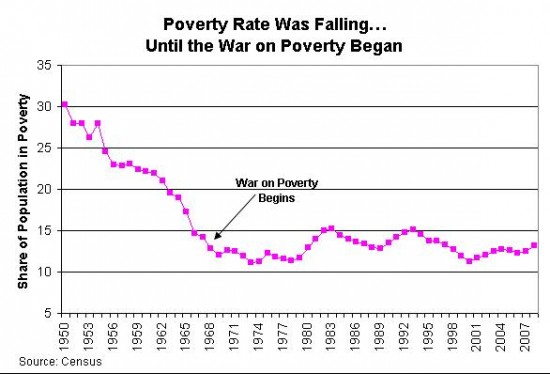Randall G. Holcombe • Thursday, January 16, 2014 •
President Obama has recently promoted inequality as a fundamental threat to our way of life, saying, “The combined trends of increased inequality and decreasing mobility pose a fundamental threat to the American Dream, our way of life, and what we stand for around the globe.” You can read the rhetoric here. Let’s look at the reality.
The president suggested policy initiatives to address these issues, so presumably, the president’s policies can make a difference. What has he done so far?
He has presided over corporate bailouts, not only declaring the Wall Street banks too big to fail, while a multitude of small businesses did fail, his policies continue to support the banking industry through low interest rates and the payment of interest on reserves held at the Fed. Banks holding bad mortgages were bailed out while individual homeowners were evicted from their homes.
While the president does not directly determine Fed policy, Bernanke was all-in on the president’s agenda, and now the president has appointed Janet Yellen as Fed chair because she supports a continuation of those policies.
The low interest rate policy has hurt small savers, who tend to keep their savings in fixed-interest assets, but has propped up the stock market where the wealthier tend to invest.
The president’s support for extended unemployment benefits has taken away some of the incentive for people to find work, which is the best way to escape poverty.
After campaigning against them, the president worked hard to preserve the “Bush tax cuts,” with ultimately just a small increase in rates for the highest-income individuals.
Then there is Obamacare, which provides financial incentives for employers to convert full-time jobs to part-time jobs to avoid the health insurance penalties, further eroding opportunities for those at the bottom of the income scale.
What has been the effect of the president’s economic policies? The unemployment rate remains high, at 6.7%, and long-term unemployment has spiked to its highest level in history, largely because of the extended unemployment benefits. The labor force participation rate has fallen from 66% in 2008 to below 63% today, so fewer people are even looking for the jobs that could help them escape poverty.
In 2008 13.2% of Americans fell below the official poverty line. By 2012 the poverty rate was 15%. The president’s policies have increased poverty.
How about the rich? The Dow Jones Industrial Average, which hovered around 8,000 when the president took office in 2009 has more than doubled to top 16,000 today.
Despite the rhetoric, the reality is that the president’s policies have created more inequality. They have hurt the poor, but Wall Street has done well.






